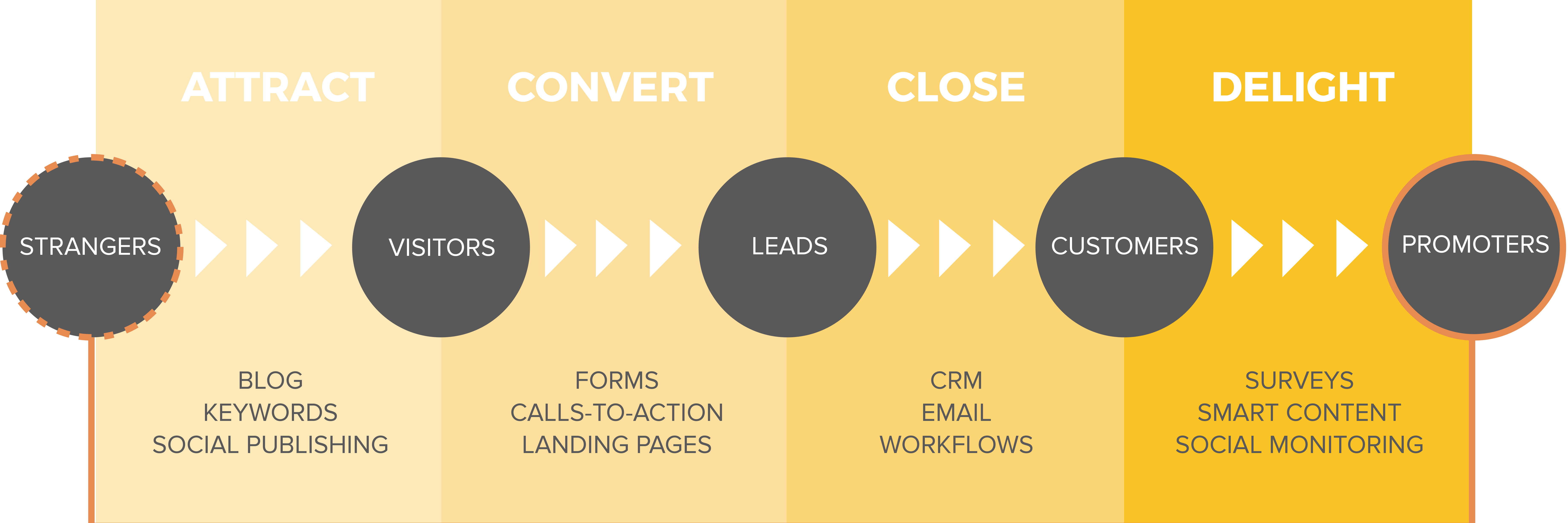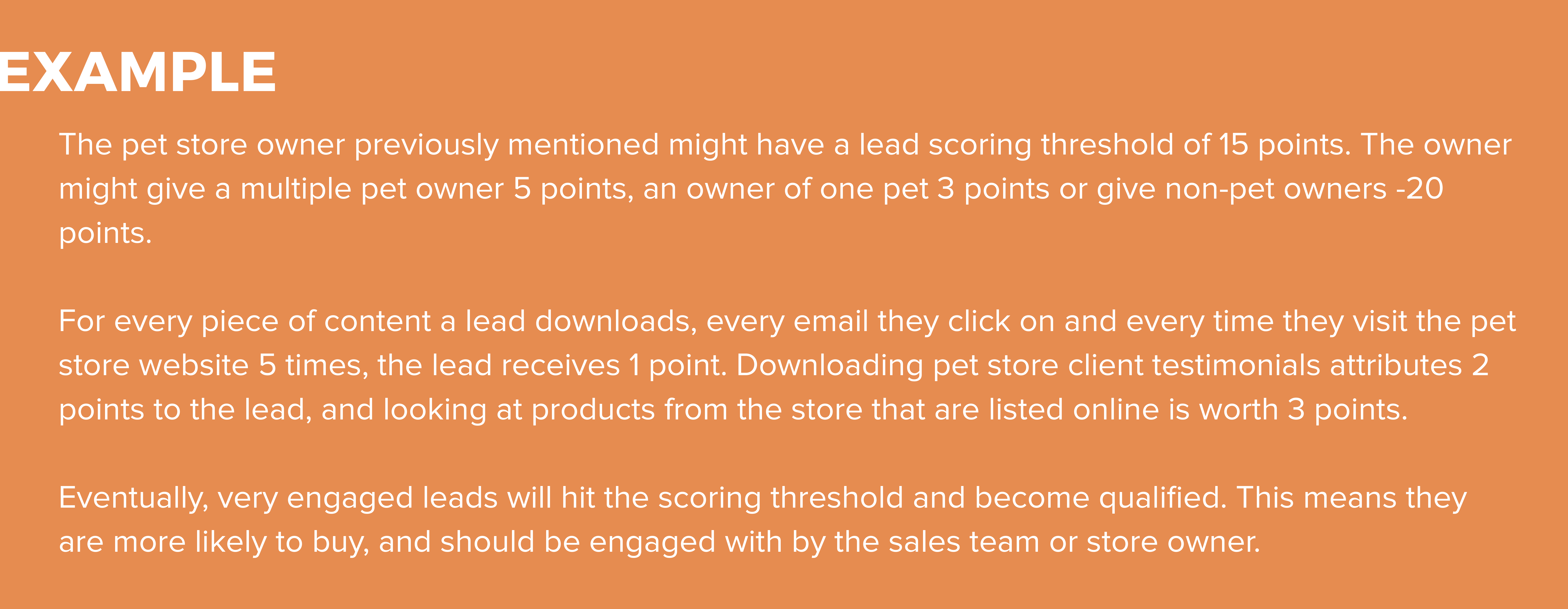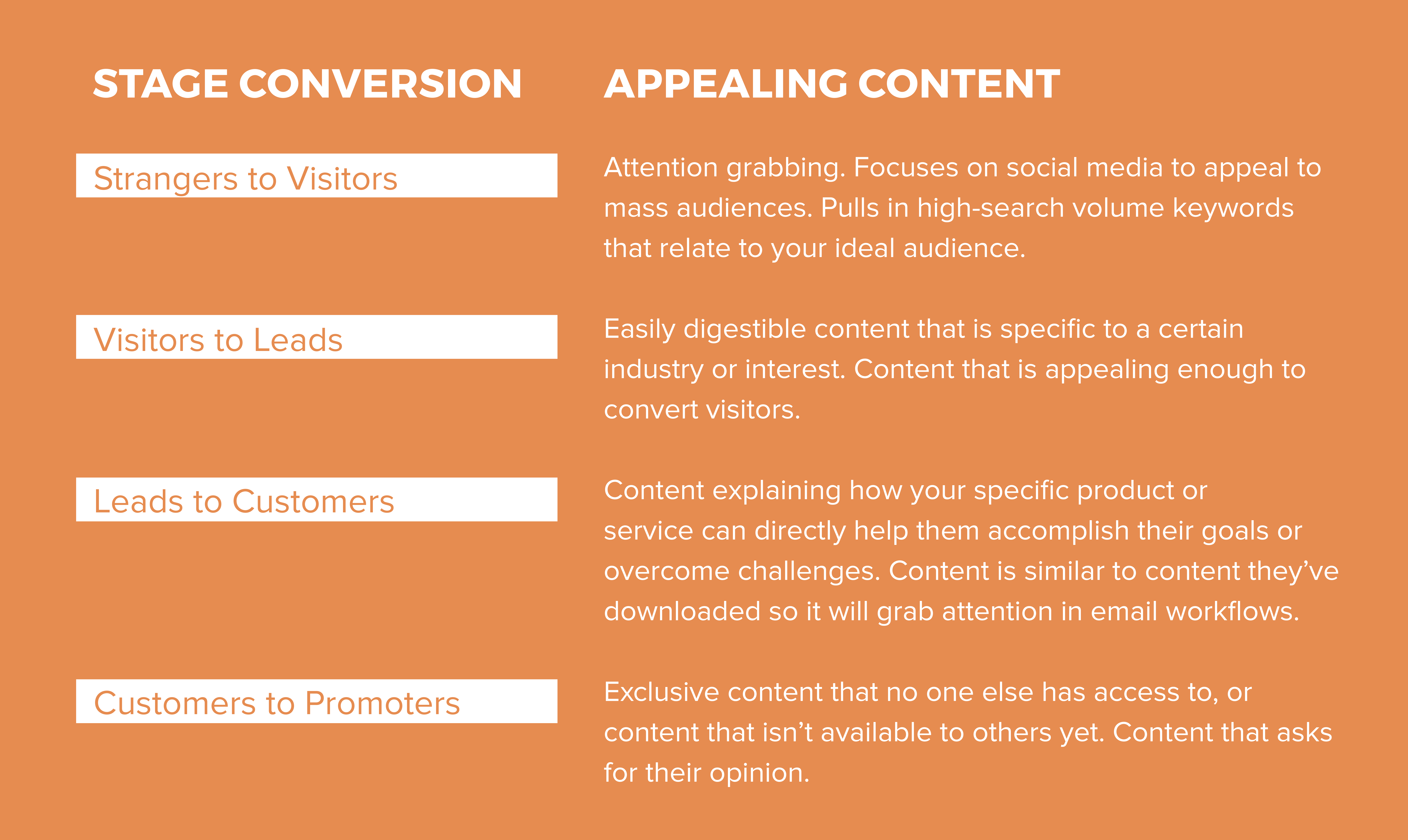INTRODUCTION
Inbound marketing is a very hot topic because it has the power to boost your company’s sales by driving informed and qualified prospects to your sales team. However, some businesses find it challenging to correctly implement the inbound marketing methodology. A lot of people think inbound marketing is simply content creation, or that it only covers the stage between turning website visitors into leads, but there is so much more to inbound marketing than meets the eye. HubSpot covers inbound marketing in-depth in this article and in the visual methodology below.

As you can see, inbound marketing is a process. It starts before you even talk to a lead and extends past the sale. So how can you use this process to boost sales? Keep reading this ebook for actionable strategies and ideas.
Want a PDF of the comprehensive guide? Download Now!
CONVERT BETTER LEADS
If you are or ever were in sales, you know the traditional sales workday—cold calling, connecting on social media or through email and even the occasional snail mail send. Everything is a proactive effort to warm up cold leads. In this model, even sales superstars have days where they want to pull their hair out.
Inbound marketing changes the way your sales team connects with prospects. Instead of reaching out to strangers, inbound marketing allows your sales team to have meaningful conversations with people who already know about your business and have a need for your product or service. Inbound marketing begins long before your sales team picks up the phone. To understand the beginning stages of inbound marketing, and how it helps you convert better leads, continue reading:
Know Your Ideal Audiences
Before you plan an inbound campaign, you have to know your audience. Define who you will create content for, and what channels they use, so you can deliver that content. If you create content that’s general enough to apply to anyone, it will not attract anyone’s attention. Have specific audiences in mind when you create a targeted campaign. To define your ideal audience, you need to create buyer personas.
Buyer personas are semi-fictional representations of your ideal customers based on market research and real data about your existing customers. It is important to note that buyer personas are not:
- Target markets
- Job titles or roles
- Dependent on specific tools or technology
- Specific real people
When creating buyer personas you should ask yourself the following questions:
- What hats does the persona wear?
- What are the goals of the persona?
- What are the persona’s challenges?
You should also consider each persona’s demographics and envision a story for them. Make sure you aren’t solely basing this information on one specific person, or on a role the person has.
The first steps to capturing your ideal audience’s attention are: knowing your ideal audience, understanding their challenges and goals and knowing the types of content they consume. It’s now time to decide which one or two you’d like to target for your inbound marketing campaign. A typical strategy is to look at how much revenue each persona brings in, then target the persona(s) that brings in the most revenue to the company.
When you start off each campaign by targeting your ideal audience you’ll set yourself up for success every time. Tailoring your message to each audience makes your prospects feel as if you are talking directly to them, you understand their challenges and you can help them reach their goals.
Produce Content for Your Ideal Audience
Now that you know your ideal audience and have a good grasp on their challenges and goals, start creating compelling content that turns strangers into leads (and ultimately, customers). In our digital world, there are many different types of content, including:
- Infographics
- Blogs
- White papers
- Memes
- Guides and Ebooks
- Case Studies
- Checklists
- Podcasts
- Interviews
- Testimonials
- Demos
- Press Releases
- Work Sheets
- Templates
- Quizzes
- Research
The list goes on, but make sure to pick items from that list of content that make sense for your audience. Some audiences may not understand what a meme is, and some audiences might not have time to read an entire research paper or white paper. If you have great content, but use the wrong medium for that message, it won’t matter how great your ideas are.
Knowing your ideal audience, their challenges and goals, and the types of content that will capture their attention is the first step to converting better leads. These first steps in inbound marketing will help you generate more qualified and educated leads for your sales team. This makes it easier for sales to have conversations, reduces the time they spend talking with less qualified prospects and increases your close ratio.

KEEP ENGAGEMENT HIGH AFTER CONVERSION
Nurture Your Leads
One of the biggest mistakes companies make when implementing inbound marketing is ending engagement after a website visitor becomes a lead. Generating leads is only the first step to taking new contacts through the sales cycle until they make a purchase decision. Make sure you continue to nurture leads once you’ve earned their attention. You can do this with:
Email Workflows
Once someone downloads one of your offers, this signals that they are interested in that specific content and can trigger an email workflow to share additional content. Email workflows allow you to “warm up” your leads by sending them content similar to their initial download. Make sure each email has a purpose, because each email should relate back to the workflow goal. A few examples for that goal could be to have your leads:
- Request a consultation
- Download another offer
- Visit your website
- Subscribe to your blog or newsletter
Once you set your goal, find content that relates to the initial download. You can send them links to your blog, additional download offers or any other types of content that relate to your offer. As an example, if you write an ebook about graphic design best practices for startups, you could send them a blog about effective branding for website design, or a video tutorial about using a specific graphic design tool.
Make sure your email workflows:
- Have delays in between email sends. Don’t send an email a day. Test different sending cadences to find what works for your leads.
- Have a hard ask. If you’re trying to reach a goal, don’t beat around the bush. Give information that directs your email recipients towards the goal you want to achieve. For example, if you want them to request a consultation, write copy about working with you and link directly to your consultation page.
- Have an ending to your workflow. Send enough emails to nurture the lead, but not annoy or overwhelm them.
Nurturing leads through email workflows will prevent engagement from being a one-time occurrence and will offer consistent connection points that help you boost sales over time.
Build Quality Content for the Entire Inbound Process
Once a lead downloads an initial offer, continue to provide quality content that will interest and drive them further through the buyer’s journey. Think about each stage of the buyer’s journey and what it means to be in a specific stage. Ask yourself what type of content it takes to move them to the next step towards purchase, while still considering their challenges and goals. Consider these suggestions:

By now you know that inbound marketing isn’t just a way to get contact information from website visitors—it’s a powerful tool that helps you attract, convert, close and delight. Consider the types of content that appeal to potential customers at every stage of inbound marketing and you will easily boost sales at your company.
Understanding Lead Scoring
How do you know if you are keeping engagement high after converting a visitor to a lead? One way to track post-conversion engagement is through lead scoring. Lead scoring is an approach used to categorize and rank your leads. When lead hits your scoring threshold, this means they are qualified. When a lead reaches that value, it means they have engaged in your content, know your business and most likely have an issue or challenge that your company can solve. But how does lead scoring actually work?
First, you need to decide what criteria you will use to identify marketing qualified leads. According to HubSpot, a marketing qualified lead is a lead who is more likely to become a customer compared to other leads based on their demographic information and their activity on your site before they become a customer. A few ideas of different criteria to include in lead scoring are:
- Persona
- Industry
- Number of clients
- Size of business/number of employees
- Number of content downloads
- Visits to your website
- Email opens or clicks within emails
You can score leads on a variety of criteria beyond this list as well. Remember that you can score lead criteria both positively and negatively. For example, if you own a pet store, and one of your personas is a “non-pet owner,” you may want to give any lead that identifies as such a larger negative score.
Of course, the main goal of lead scoring is to move people to become qualified, so you’ll need to consider what each scoring criteria is worth to you and your business. Let’s go back to the pet store owner example. If someone identifies as a “multiple pet owner,” you’ll need to consider what that information is worth. Do you find that most of your customers are multiple pet owners? If so, you may want to score that persona at a higher level. Go through your list of prospect attributes and make sure the value that you apply to each makes sense.

When you’ve scored each criterion, make sure you figure out a final lead score that determines that someone has become a marketing qualified lead. Consider:
- How the criteria work together to reach certain scores
- The path your current customers took to become customers
- What it would take to reach a certain score—for example, if someone has to simply visit your website a few times to hit the score, it probably isn’t high enough
- Including your sales team; they should be involved in the entire process, and can provide you with quality feedback as you continuing scoring leads
The lead scoring process isn’t a one-time meeting. It takes tweaking and continuous communication with your sales team to create the best lead nurturing system that will eventually warm up quality leads and help you boost sales.
Give Sales the Resources They Need
Inbound marketing encompasses not only every part of the sales process, but also includes both marketing and sales. A huge part of inbound marketing is content creation, and if you’ve ever been a marketer or salesperson, you know that sales always needs fresh, relevant and tailored content to keep engagement high and close deals.
After a prospect becomes a lead, your sales team can incorporate the inbound marketing content you’ve created to support their process. They can use everything from blog posts, ebooks, checklists, videos and more to teach prospects, build credibility and close business faster. So how can you make sure you continue to make the content that your sales team needs? Communication is key. Implement any of the following strategies with sales to ensure you work together to build great content:
- Hold biweekly, monthly or quarterly meetings to plan out your content and ask your sales team for feedback on their prospects, including goals, challenges and objections.
- Ask the director of sales, or even individual sales team members, to write for your blog. This strategy helps you focus your energy elsewhere and allows the sales team to build credibility.
- Track marketing analytics. Marketers and business owners examine metrics like content download rates, as an example, to see what content is of interest to prospects. When you review these metrics and find successful strategies, create similar content or build off of that idea. Make sure you connect with sales to find additional information on the questions prospects want answer to.
- Work with sales on messaging and positioning. Great content can fall short if your sales team doesn’t know the message behind it. Make sure sales understands and even reads all of your marketing content as it comes out. Also, make sure they position themselves correctly. As an example:
- “I saw you downloaded our ebook, so I thought I’d call,” is similar to, “I saw you downloaded our ebook on increasing workplace productivity. We’ve got some strategies that I think you’ll find beneficial.” However, the latter puts the salesperson in a better position to have a conversation
Sales and marketing teams have a symbiotic relationship. They need to work together to create quality content—and when they do, increased revenue follows.

FOCUS ON CUSTOMERS TO INCREASE SALES,
BUILD BETTER CONTENT & BOOST REFERRALS
Increase Customer Sales and Referrals
You may have heard that 80% of your revenue comes from 20% of your current customers—and that is true for many businesses. So while you continue to boost sales by finding new prospects through inbound marketing, don’t forget about the quality customer audience you’ve already acquired. Once a customer buys into your company and product, it becomes exponentially easier to:
- Sell them additional products or services
- Upsell them on add-ons or additional functionality
- Leverage their network and gain referrals from them
Inbound methodology is a cycle , not a straight line, and referrals actually complete that cycle.
When customers refer their friends and colleagues to you, remember to reward them. Some companies do this by sending their customers gift cards, taking them to dinner, giving them a discount on their current product subscription or providing them with exclusive content or information about their products and services. No matter how you decide to thank your customers, it’s important to provide an incentive to give you more referrals in the future.
It is crucial to remember that inbound marketing doesn’t end once your leads become customers. It’s a continuous process that transforms customers into promoters of your brand as you delight them with valuable content.
Build Better Content With the Help of Customers
As you share valuable content with your customers, work on building a strong rapport with them. This will allow you to eventually build content about your working relationship. Examples of this are:
- Case studies
- Testimonials
- Interviews
- Demo References
- Product Reviews
When customers help you create content, be sure to thank and reward them. The content they help create should be shared with leads who are in the process of buying (and hopefully converting to become customers). It will move them further down your funnel and help you boost sales.
CONCLUSION
Inbound marketing is incredibly effective because it avoids one-and-done communication with your leads, and encompasses every stage of the inbound marketing methodology. Because every stage of your relationship with potential customers—strangers, visitors, leads, customers or evangelists—is involved in inbound marketing, it’s important to remember that inbound is more than just content creation, or engaging people who are already leads. The strategies you’ve read about in this ebook will help you through the entire inbound process.
Use inbound marketing to convert better leads, keep engagement high throughout your process and focus on your existing customers to help you increase sales. The power of inbound marketing is amplified when your marketing and sales teams come together to create a streamlined process that will become a revenue generating machine.
.png?width=233&name=ACC_Logo_2019-Horizontal-Light%20(1).png)


